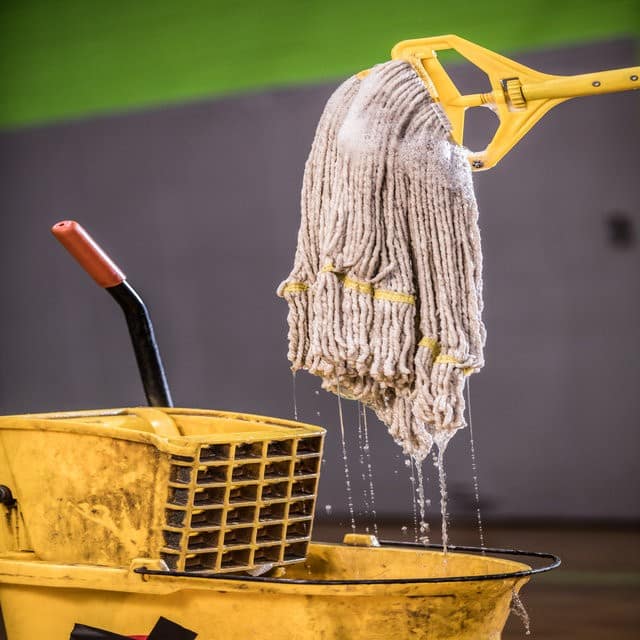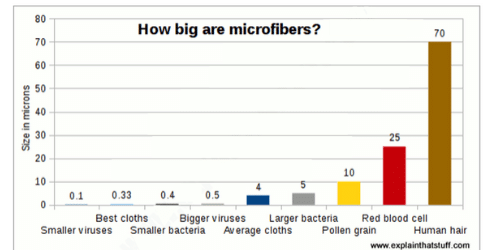
Cotton String Mops vs Microfiber String Mops: 8 Considerations for Commercial Floor Cleaning
Whether you own a cleaning business or procure commercial cleaning supplies for a facility, you understand the multitude of options when it comes to purchasing cleaning tools, specifically floor cleaning solutions. When it comes to choosing a mop head, cotton string mops were traditionally the selection of choice due to its gentle fabric and ability to mop up large amounts of liquid. Yet, with microfiber’s emergence in the last 20 years as the premium cleaning material of choice, there’s value in investigating the differences between cotton string mops vs. microfiber string mops to see which option will work best for you.
What is Microfiber?
Introduced in the 1990s, microfiber is a synthetic fiber that is extremely fine. It is made up of thousands of small tiny fibers that are each smaller than ⅕ the diameter of human hair. It uses these small fibers to break up dirt as compared to cotton, which uses bigger fibers.
As the idea of microfiber caught on, it eventually proved to clean more efficiently than the traditional cotton string mop. Fast-forward to today and further analyzing the performance of microfiber mops against its cotton competition may have you making an informed switch to the way you clean floors.
1. Is a Cotton String Mop or Microfiber Mop Tougher on Germs and Microbes?
Microfiber is made from synthetic materials and is a very fine blend, allowing it to trap and hold bacteria, dust, and dirt within the actual fibers. Compare this to cotton, which pushes dirt and debris around instead of picking it up. And because cotton comes from organic materials, it can be a desirable home for undesirable odors and bacteria.
According to a study published by the American Journal of Infection Control, microfiber mops removed far more microbes than standard cotton string mops. This finding amounted to a difference of 95% removed microbes with standard detergent using a microfiber mop, while only 68% of microbes were removed with standard detergent and a cotton string mop.
The best cloths are .33 microns wide, which means it can clean up everything to the right of it (and miss anything to the left of it)

2. Which Mop is Better for the Environment?
Microfiber can be thought of as a somewhat green product given that it requires less water as well as cleaning products. According to the EPA, conventional Wet Loop Mops use 105 gallons of water per 100 rooms. Microfiber uses only 5 gallons per 100 rooms.
Using less cleaning solution is incredibly important because many professional cleaning products contain chemicals that will eventually be washed down the drain after being used. They are then absorbed into the air, soil, and water.
Conventional wet loop mops use $11.55 of cleaning solution per 100 rooms, while microfiber uses $.50 of cleaning solution per 100 rooms.
3. Which Mop is More Expensive?
Microfiber mops can cost up to three times more than a cotton mop head. However, they also last longer, standing up to more frequent washings (some up to 500) and maintain effectiveness longer. So, whereas the initial price may seem like a significant investment, microfiber’s durability and effectiveness produce an ROI within the first 150 washings.
.
Additionally, when factoring in-floor cleaning costs, other than the primary cost of the mop head, it’s also important to look at other cost components, such as:
● Frequency of mop head replacements
● Cost of water and cleaning solutions (The most common sizes of cotton string mops weigh between 16 and 24 ounces; these mops can triple in weight when wet due to their level of absorbency.)
● Loss of employee labor from physical injury due to the weight of mop and repetition of movement
● Incidental costs of cross-contamination within a facility
4. Which Mop Cleans More Surface Area?
According to an EPA study, the density of microfiber allows it to hold six times its weight in water as compared to regular cotton mops. This means that one mop head can go for about 400-500 square feet at a time before being stored for washing.
On the other hand, regular cotton mops can go for about 100 square feet before needing to be dunked back into the water and wrung out.
5. Which Mop is Easier to Use?
Ease of use is associated with a few characteristics such as maneuvering, carrying, ease of wringing out, setting up, and ability to clean both small and large areas.
One consideration to make would be if there was a very large, greasy spill that you needed to clean in an industrial complex. In this case, microfiber may not be the best option due to its small fibers and a cotton mop would most likely do a better job and be easier to use.
For other jobs, cotton mops need to be wrung out after being fully soaked in water and solution, which puts a higher amount of strain on the worker’s body. Cotton string mops are also 80% heavier than microfiber and do not have the ability to connect a water source directly to the mop.
6. Which Mop is Easier to Clean and Dry for Reuse?
Both cotton mops and microfiber mops can be easily laundered after each use. However, microfiber mops typically withstand the repetitive laundering process better than their cotton counterpart which take a toll with each wash. Cotton mop heads tend to shed strands and easily knot during the process, only adding to their shorter shelf life when compared to microfiber.
7. Does a Cotton String Mop or Microfiber Mop Last Longer?
Regarding the mop head, one string mop head normally lasts around 15-30 washes, while microfiber heads usually have a span of about 150-200 washes. Microfiber is more durable than cotton, therefore it lasts longer. However, cotton holds up better than microfiber when bleach or acidic chemicals are required. The use of these products can break down and destroy microfiber.
What the Professionals Recommend
When choosing a mop for commercial floor cleaning, there are benefits to every type of mop. Although the upfront costs might be a bit higher, when you take into account your total cleaning costs – time, staffing, loss of work, etc. – in the long run microfiber is going to be the most economical option when compared to a cotton string mop.
Want to See How Floor Cleaning Professionals are Using Microfiber String Mops for a Faster, Safer and Cleaner Experience?
Take a look at Unger’s comprehensive product line of professional floor cleaning products

